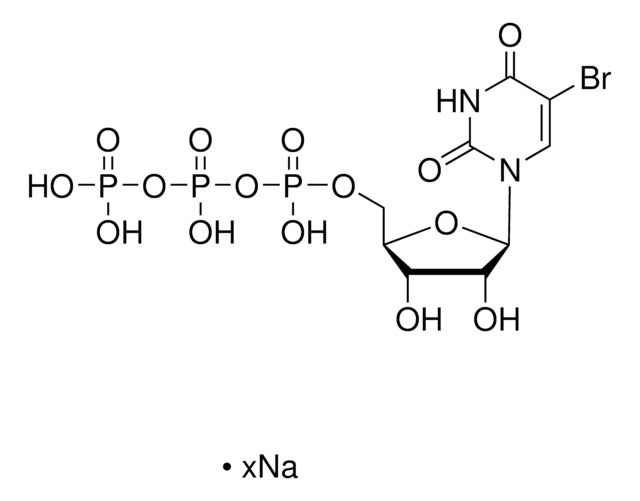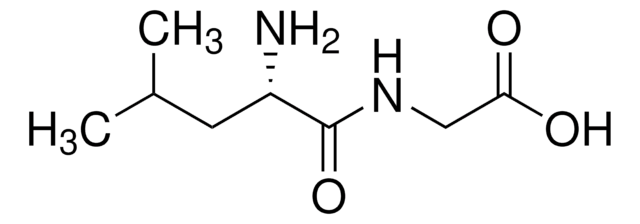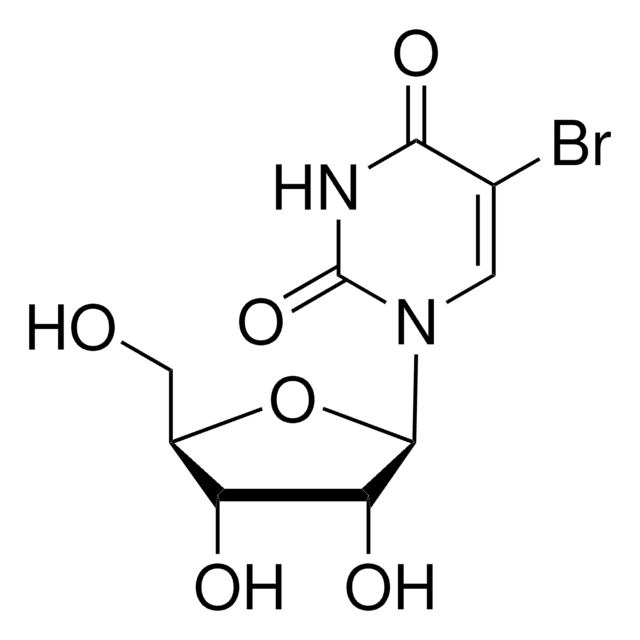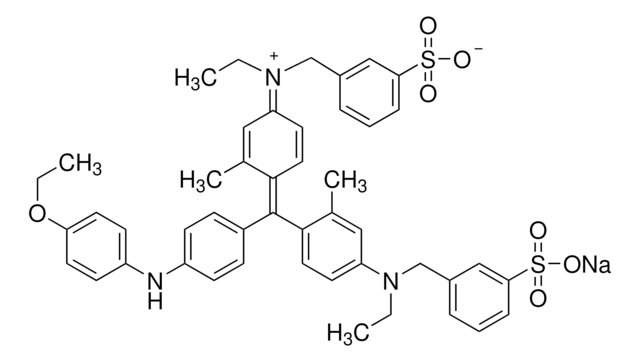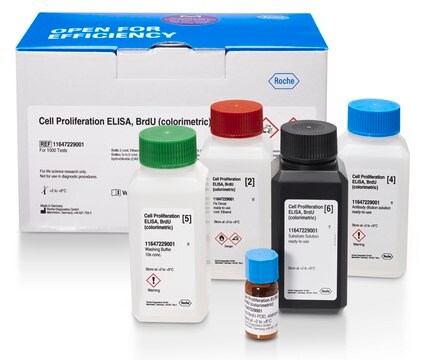B0631
5-Bromo-2′-deoxyuridine 5′-triphosphate sodium salt
≥90%
Synonym(s):
5-BrdUTP
Sign Into View Organizational & Contract Pricing
All Photos(1)
About This Item
Empirical Formula (Hill Notation):
C9H14BrN2O14P3
CAS Number:
Molecular Weight:
547.04
MDL number:
UNSPSC Code:
41106305
PubChem Substance ID:
NACRES:
NA.51
Recommended Products
biological source
synthetic (organic)
Assay
≥90%
form
powder
solubility
water: 50 mg/mL, clear, colorless to faintly yellow
storage temp.
−20°C
SMILES string
[Na].OC1CC(OC1COP(O)(=O)OP(O)(=O)OP(O)(O)=O)N2C=C(Br)C(=O)NC2=O
InChI
1S/C9H14BrN2O14P3.Na.H/c10-4-2-12(9(15)11-8(4)14)7-1-5(13)6(24-7)3-23-28(19,20)26-29(21,22)25-27(16,17)18;;/h2,5-7,13H,1,3H2,(H,19,20)(H,21,22)(H,11,14,15)(H2,16,17,18);;
InChI key
UWZGQOWZUSBZMC-UHFFFAOYSA-N
Related Categories
General description
5-Bromo-2′-deoxyuridine 5′-triphosphate is used for incorporation into DNA for studying normal and tumor cell proliferation profiles.
Application
5-Bromo-2′-deoxyuridine 5′-triphosphate (5-BrdUTP) may be used as a labeling TdT substrate for terminal deoxynucleotidyl transferase (TdT) reactions or for DNA synthesis. BrdUTP is also used as an effective mutagenic agent. 5-BrdUTP labeling may be detected by immunological techniques or 5-BrdUTP may be derivitized by biotinylation or other methods for detection by fluorogenic or chromogenic methods.
5-Bromo-2′-deoxyuridine 5′-triphosphate sodium salt has been used:
- in the labelling of 3′-OH termini of fragmented DNA with double stranded breaks in african green monkey kidney cells
- to label cleaved DNA ends in apoptosis assay in avian tissue sections
- for incorporation into mice prostates for immunohistochemistry studies
Storage Class Code
11 - Combustible Solids
WGK
WGK 3
Personal Protective Equipment
dust mask type N95 (US), Eyeshields, Gloves
Choose from one of the most recent versions:
Already Own This Product?
Find documentation for the products that you have recently purchased in the Document Library.
Customers Also Viewed
Avian models in teratology and developmental toxicology
Developmental Toxicology, 85-103 (2012)
Eisuke Gotoh
Chromosoma, 116(5), 453-462 (2007-05-16)
A basic question of cell biology is how DNA folds to chromosome. Numbers of examples have suggested the involvement of DNA replication in chromosome structure formation. To visualize and identify the dynamics of chromosome structure formation and to elucidate the
The impact of bcl-2 expression and bax deficiency on prostate homeostasis in vivo
Bruckheimer EM, et al.
Oncogene, 19(20), 2404-2404 (2000)
A Wojcik et al.
Cytogenetic and genome research, 104(1-4), 304-309 (2004-05-27)
The DNA lesions responsible for the formation of sister chromatid exchanges (SCEs) have been the object of research for a long time. SCEs can be visualized by growing cells for either two rounds of replication in the presence of 5-bromo-2'-deoxyuridine
Zbigniew Darzynkiewicz et al.
Methods in molecular biology (Clifton, N.J.), 682, 91-101 (2010-11-09)
Extensive DNA fragmentation that generates a multitude of DNA double-strand breaks (DSBs) is a hallmark of apoptosis. A widely used approach to identify apoptotic cells relies on labeling DSBs in situ with fluorochromes. Flow or image cytometry is then used
Our team of scientists has experience in all areas of research including Life Science, Material Science, Chemical Synthesis, Chromatography, Analytical and many others.
Contact Technical Service
